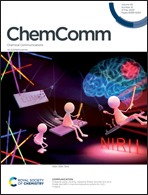Formation of covalent metal–carbon contacts assisted by Ag+ for single molecule junctions†
Abstract
Covalent metal–carbon (M–C) contacts have long been pursued for constructing robust and high-performance molecular devices. Existing methods for creating such contacts usually rely on direct chemical reactions between metal electrodes and designed molecular ligands. An inherent limitation of this approach is that the commonly used metal electrodes (e.g., Au) are chemically inert, making it generally difficult to form covalent M–C bonds with molecules. Intriguingly, employing the scanning tunneling microscope-break junction technique, we find that simply adding Ag+ ions to molecular solution enables direct covalent bonding of terminal alkynes to Au electrodes. The bonding process is driven by Ag+ ion coupled in situ reactions and efficiently creates covalent Au/Ag–C interfaces in single molecule junctions. This metal ion assisted method avoids the need for complex synthesis of molecular ligands and works robustly for a wide range of alkyne-terminated molecules, offering a facile and versatile approach for precisely tuning the metal–molecule interface.

- This article is part of the themed collection: 2023 Emerging Investigators


 Please wait while we load your content...
Please wait while we load your content...